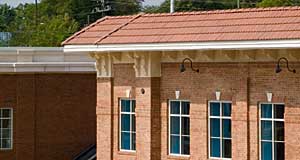Concrete Tiles: Durable, Sustainable Roofing Materials Integrate Design and Performance
Manufacturing Process
There are four basic ingredients for making tiles: sand or aggregates, cement, color or pigment for aesthetics, and water. These are mixed together to form a solid concrete material.
Not just any sand can be used for making concrete or concrete roof tiles. First, the sand must form to the correct grading specification. Grade refers to the size of different grains of sand. When sand is too coarse, the cement cannot fill the void space between sand grains. The effect on the final product is an open or coarse surface texture leading to increased permeability and higher potential for efflorescence. Sands that are too fine tend to produce tiles that are less strong and less durable than expected. These mixes require a high water ratio, increasing the chances of the grains' interlock not being straight (lock splay) or of surface bubbling, the presence of small bubbles or rings on the surface.
|
Sand must be chemically, mineralogically, and physically suitable. It must be free of contaminants such as chloride, which is present in marine sand, can interfere with the cement hydration, and may reduce long-term strength and durability performance. Physical properties of the sand, including shape, may also affect its suitability. Finally, the sand must be of consistent quality. When selecting aggregates, adequate reserves of sand must be available.
Once the raw materials have been selected, they are broken, crushed, sampled, and fed to a rotary kiln. The kiln typically operates at 2600 degrees Fahrenheit for the production of Portland cement. Heating to this temperature results in decomposition of the clay minerals and de-carbonation of the calcite, enabling the production of calcium silicates. This process makes the concrete stronger. Finally, the powdered cement from the kiln is cooled before milling to the required fineness. Gypsum is added to control its setting rate, producing cements for different purposes. These are referred to as Type I, II, III, IV, and V.
Type I Portland cement is known as common cement. It is generally assumed unless another type is specified. It is commonly used for general construction especially when making precast and precast, pre-stressed concrete that is not to be in contact with soils or ground water. Type II is known to have moderate sulfate resistance with or without moderate heat of hydration. This type of cement costs about the same as Type I. Cement is increasingly sold as a blend of Type I/II on the world market. Type III is known for its high early strength. Type IV Portland cement is generally known for its low heat of hydration. Type V is known for its extreme sulfate resistance.










